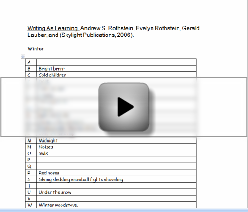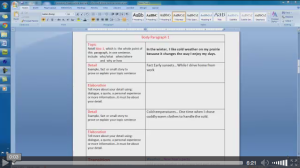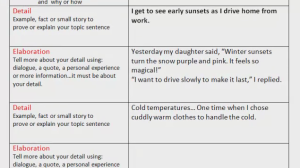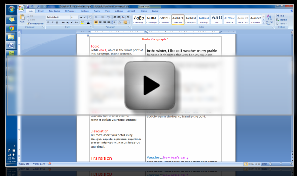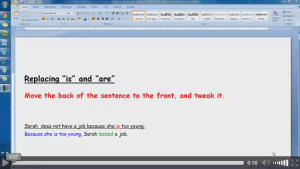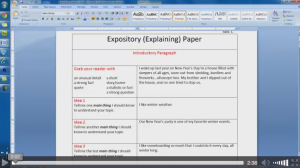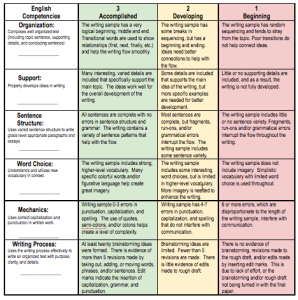Unit Objective
Write a developed paragraph using the thinking routine “Claim/ Support/Elaboration” Apply the writing process and the six traits of writing.
Background and Rationale
Paragraphs are the building blocks of writing compositions and they are often defined as having a certain number of sentences with a beginning, middle and end. However, paragraphs need unity and coherence in order to express one main idea, so length does not determine whether a group of sentences is a paragraph. This lesson is important in teaching students how to apply the writing process to develop organized paragraphs using the six traits of writing, scaffolding into writing. The six traits of writing will be used to help the students to revise for word choice, sentence structure, style, conventions, organization, and overall development.
In this lesson, students will learn to apply a thinking routine “Claim, Support, Elaboration” to develop a coherent and unified paragraph, focusing on the topic sentence, or claim, in which the paragraph is about. Through teacher modeling, the use of tutorials, and student- centered activities, students will further develop their understanding of writing developed paragraphs. Differentiation: Students will be provided a variety of materials and instruction in order to customize the learning experience. This includes: Audio and Visual tutorials; graphic organizers; class discussion; sharing examples.
Lesson Objectives
Apply the thinking routine “Claim/support/elaboration to draft a paragraph on a chosen topic.
Objective |
Bloom’s Verb |
|---|---|
|
Brainstorm a topic of choice to generate ideas for a paragraph |
Remembering |
| Compose a topic sentence or claim for a paragraph | Creating |
| Use a graphic organizer for “Claim, Support, Elaboration” for organizing ideas. | Applying |
| Post examples of different aspects of paragraph in discussion forum for feedback from peers | Understanding |
| Provide peer feedback on posted examples in discussion forum | Evaluating |
|
Revise the paragraph for word choice, sentence structure, and style. |
Analyzing |
| Edit for spelling, punctuation, and capitalization. | Evaluating |
Bloom’s Taxonomy
Creating (highest level)
Common Core / State and District Standards
-
CCSS.ELA-Literacy.W.5.2 Write informative/explanatory texts to examine a topic and convey ideas and information clearly.
-
CCSS.ELA-Literacy.W.5.2.a Introduce a topic clearly, provide a general observation and focus, and group related information logically; include formatting (e.g., headings), illustrations, and multimedia when useful to aiding comprehension.
-
CCSS.ELA-Literacy.W.5.2.b Develop the topic with facts, definitions, concrete details, quotations, or other information and examples related to the topic.
-
CCSS.ELA-Literacy.W.5.2.c Link ideas within and across categories of information using words, phrases, and clauses (e.g., in contrast, especially).
-
CCSS.ELA-Literacy.W.5.2.d Use precise language and domain-specific vocabulary to inform about or explain the topic.
-
CCSS.ELA-Literacy.W.5.2.e Provide a concluding statement or section related to the information or explanation presented.
Learning and Innovation Skills (P21.org)
Creativity and innovation
Think Creatively:
-
Use a wide range of idea creation techniques (such as brainstorming)
-
Create new and worthwhile ideas (both incremental and radical concepts)
-
Elaborate, refine, analyze and evaluate their own ideas in order to improve and maximize creative efforts
Work Creatively with Others:
-
Develop, implement and communicate new ideas to others effectively
-
Be open and responsive to new and diverse perspectives; incorporate group input and feedback into the work
Reason Effectively:
-
Analyze how parts of a whole interact with each other to produce overall outcomes in complex systems
Make Judgments and Decisions
-
Effectively analyze and evaluate evidence, arguments, claims and beliefs
-
Analyze and evaluate major alternative points of view
-
Reflect critically on learning experiences and processes
Communicate Clearly
-
Articulate thoughts and ideas effectively using oral, written and nonverbal communication skills in a variety of forms and contexts
Collaborate with Others
-
Demonstrate ability to work effectively and respectfully with diverse teams
Life and Career Skills (P21.org)
Flexibility and Adaptability: Be Flexible
-
Incorporate feedback effectively
-
Deal positively with praise, setbacks and criticism
Initiative and Self Direction: Work Independently
-
Monitor, define, prioritize and complete tasks without direct oversight
Productivity and Accountability: Produce Results
-
Multi-task
-
Participate actively, as well as be reliable and punctual
-
Present oneself professionally and with proper etiquette
-
Collaborate and cooperate effectively with teams
-
Respect and appreciate team diversity
-
Be accountable for results
Information, Media, and Technology Skills (P21.org)
Create Media Products
-
Understand and utilize the most appropriate media creation tools, characteristics and conventions
Apply Technology Effectively
-
Use technology as a tool to research, organize, evaluate and communicate information
-
Use digital technologies (computers, PDAs, media players, GPS, etc.), communication/networking tools and social networks appropriately to access, manage, integrate, evaluate and create information to successfully function in a knowledge economy
[/color-box]
Lesson – Introduction
The lesson will begin with using a thinking routine Think, Puzzle, Explore. This will help students connect to prior knowledge, to stimulate curiosity and to lay the groundwork for independent inquiry as they begin to learn to develop paragraphs for the six traits of writing.
-
Begin by giving students a few moments to consider what they Think about paragraph writing. Have them to brainstorm all that they have learned about paragraph writing and what good writing might look like.
-
Then ask what puzzles them about writing paragraphs. Have them to think about the parts of a paragraph as well as all of the traits. What do they have questions about or what do they not understand?
-
Finally, ask them what they want to explore further. Where might they find the information that they are looking for? What ways could they gain new insight on writing paragraphs effectively?
Then, work as a whole class or in small groups and brainstorm ideas in the three areas. Some may have misconceptions about paragraphs writing that can be worked through, others will discover a specific skill that they want to learn to explore to enhance their writing.
Lesson Activities and Procedures
This lesson will be taught through explicit instruction, Making Thinking Visible, Think-Pair -Share, Claim/Support/Elaboration and differentiation. The lesson will focus on directing students’ attention towards writing developed paragraphs. Explicit instruction begins with setting the stage for learning; followed by a clear explanation of what to do (telling); followed by modeling of the process (showing/ Teacher Think Aloud); followed by multiple opportunities for practice (guiding); until independence is attained. Explicit instruction moves systematically from extensive teacher input and initially reduced student responsibility to total student responsibility and minimal teacher involvement at the conclusion of the learning cycle.
Student Procedure |
Teacher Procedure |
Materials |
|---|---|---|
| The students will make a copy of their digital paragraph graphic organizer, brainstorming list, and word bank and organize it in their Google drive in a writing folder. For organizational purposes, all three graphic organizers for brainstorming, drafting a paragraph, and revising for word choice can be combined onto one document. | The teacher will provide a copy of the graphic organizer and explain how each section will be used. The teacher will demonstrate how the links on the document can access resources for compiling higher level words to use for revisions, as well as provide further examples for incorporating into the writing piece. | |
| The student will take notes on how to provide feedback when evaluating peer examples of writing. | The teacher will teach a mini lesson on how to provide proper and adequate feedback to peer writing examples. | feedback expectations |
| The student will use the thinking routine “Claim, Support, Elaboration” for drafting a paragraph. They will apply the knowledge of the routine to help them develop thoughtful interpretations. They will be encouraged to reason with evidence. (Ritchhart, 2011). | The teacher will explain how to use the thinking routine, “Claim/Support/Elaboration for paragraph development as differentiation is applied through the use of a graphic organizer. | Thinking routine |
| The students will compose a topic sentence or claim for their paragraph topic after receiving notes on broad and narrow topics. | The teacher will provide information about writing a topic sentence that contains the 5Ws: who/what/when/where/why or how? | topic sentence notes |
| The students will create a customized wordbank containing higher level words to incorporate into their paragraphs. | The teacher will guide the students through the process of locating higher level word choice to incorporate into their paragraph. | customized word bank Sample Word bank |
| The students will post 10 of their best word bank examples that range from specific nouns to figurative language. They will give feedback to three of their classmates. | The teacher will create a discussion link on a Learning Management System (LMS) such as Haiku, Edmodo, Etc. for the students to post their examples. Discussion will remind the students of the benefits from learning from others and borrowing ideas to help shape their writing. |
|
| The students will begin the prewriting stage of the writing process by brainstorming. They will watch a tutorial on how to accurately use the brainstorming document to brainstorm ideas for their paragraph. |
They will use their own brainstorming list to compile ideas on a topic of their choice.
The teacher will show the tutorial on how to use the ABC brainstorming list.
The students will post 10 of their best brainstorming ideas to the discussion forum on Haiku or Edmodo. They will give feedback to three of their classmates.
The teacher will share some great posts as discussion is lead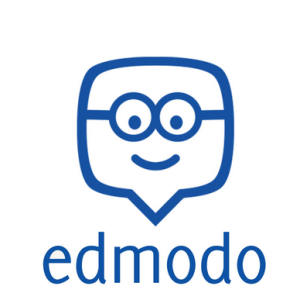
The student will watch Cronin’s Tutorial 1, Tutorial 2, and Tutorial 3 (2012) on writing supports and elaborations for their paragraph and follow the instructions and examples.
The teacher will instruct the students to use the graphic organizer for organization (one of the six traits of writing) that follows the thinking routine “Claim, Support, Elaboration.” The topic sentence that has already been composed will be placed in the top of the organizer for the claim. The learner will come up with three supports that will each be followed by an elaboration for greater development, another of the six traits of writing.
The student will post the best support and elaboration to the Haiku or Edmodo discussion forum. They will give feedback to three of their classmates.
The teacher will create a discussion link on a Learning Management System (LMS) such as Haiku, Edmodo, Etc. for the students to post their examples. Discussion will remind the students of the benefits from learning from others and borrowing ideas to help shape their writing.
After the draft of the paragraph has been completed, The students will revise according to the feedback they have received from the discussion forum.
The teacher will instruct the students to revise their paragraphs for word choice (one of the six traits of writing) by using their word bank to replace overused or dull words. They will also use words that were shared by their classmates on the discussion forum.
The students will watch a tutorial on verb quality and revise their verb choice accordingly.
The teacher will provide the students access to the tutorial and instruct them to apply their knowledge to revise their paragraph for verb choice.
The students will watch Cronin’s tutorial on sentence structure (2012), another trait of writing, and revise accordingly.
The teacher will provide the students access to the tutorial and instruct them to apply their knowledge to revise their paragraph for sentence structure.
The students will edit their writing for spelling, capitalization, and punctuation.
Lesson – Closure
Students will share their published paragraph with the class as well as post it on the Haiku discussion forum to make it visible for other sections of classes.
Student Work Example
[gview file=”https://www.mtvt.org/wp-content/uploads/2015/03/MTVTStudentParagraphExample.pdf”]
Teacher Reflection
[youtube]https://www.youtube.com/watch?v=3LSEcysSyWI[/youtube]
Cronin, Ginny (2012). Edmodo lesson tutorials. East Valley Washington Academy of Arts and Technology FLEX Spokane Valley, WA Ritchhart, R., Church, M., & Morrison, K. (2011). Making Thinking Visible: How to Promote Engagement, Understanding, and Independence for All Learners. San Francisco, CA: Jossey-Bass. Writing As Learning. Andrew S. Rothstein, Evelyn Rothstein, Gerald Lauber, and (Skylight Publications, 2006.References:

